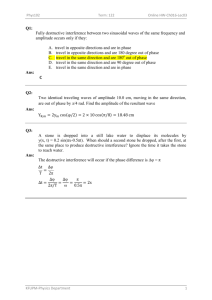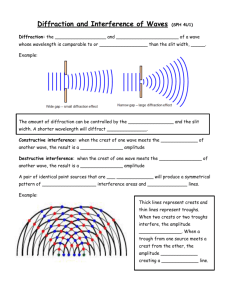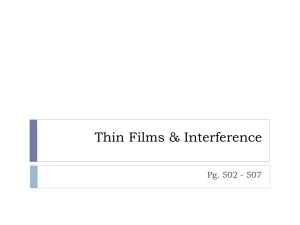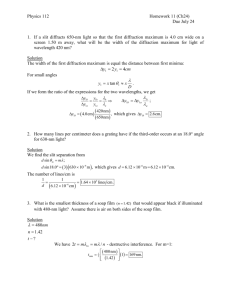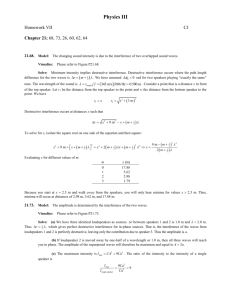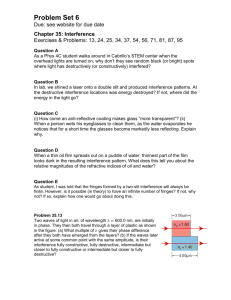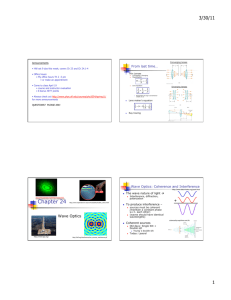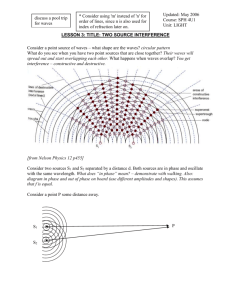Explanation to mc
advertisement
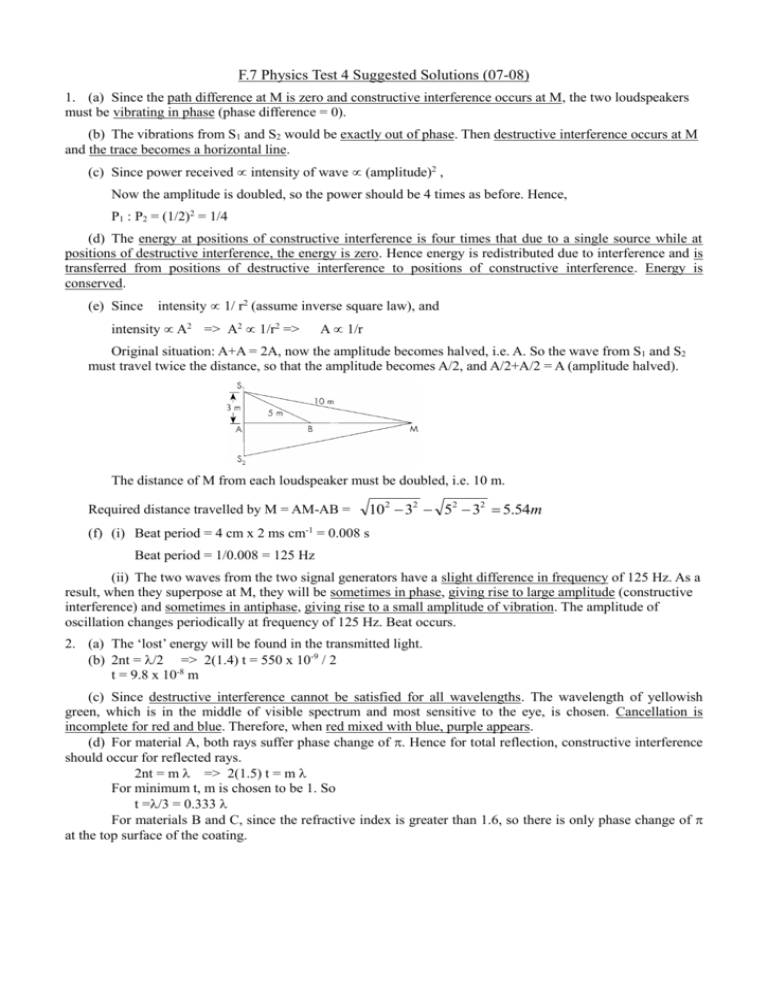
F.7 Physics Test 4 Suggested Solutions (07-08) 1. (a) Since the path difference at M is zero and constructive interference occurs at M, the two loudspeakers must be vibrating in phase (phase difference = 0). (b) The vibrations from S1 and S2 would be exactly out of phase. Then destructive interference occurs at M and the trace becomes a horizontal line. (c) Since power received intensity of wave (amplitude)2 , Now the amplitude is doubled, so the power should be 4 times as before. Hence, P1 : P2 = (1/2)2 = 1/4 (d) The energy at positions of constructive interference is four times that due to a single source while at positions of destructive interference, the energy is zero. Hence energy is redistributed due to interference and is transferred from positions of destructive interference to positions of constructive interference. Energy is conserved. (e) Since intensity 1/ r2 (assume inverse square law), and intensity A2 => A2 1/r2 => A 1/r Original situation: A+A = 2A, now the amplitude becomes halved, i.e. A. So the wave from S1 and S2 must travel twice the distance, so that the amplitude becomes A/2, and A/2+A/2 = A (amplitude halved). The distance of M from each loudspeaker must be doubled, i.e. 10 m. Required distance travelled by M = AM-AB = 10 2 32 52 32 5.54m (f) (i) Beat period = 4 cm x 2 ms cm-1 = 0.008 s Beat period = 1/0.008 = 125 Hz (ii) The two waves from the two signal generators have a slight difference in frequency of 125 Hz. As a result, when they superpose at M, they will be sometimes in phase, giving rise to large amplitude (constructive interference) and sometimes in antiphase, giving rise to a small amplitude of vibration. The amplitude of oscillation changes periodically at frequency of 125 Hz. Beat occurs. 2. (a) The ‘lost’ energy will be found in the transmitted light. (b) 2nt = /2 => 2(1.4) t = 550 x 10-9 / 2 t = 9.8 x 10-8 m (c) Since destructive interference cannot be satisfied for all wavelengths. The wavelength of yellowish green, which is in the middle of visible spectrum and most sensitive to the eye, is chosen. Cancellation is incomplete for red and blue. Therefore, when red mixed with blue, purple appears. (d) For material A, both rays suffer phase change of . Hence for total reflection, constructive interference should occur for reflected rays. 2nt = m => 2(1.5) t = m For minimum t, m is chosen to be 1. So t =/3 = 0.333 For materials B and C, since the refractive index is greater than 1.6, so there is only phase change of at the top surface of the coating. 2nt - /2 = m For minimum t, m is chosen to be zero, hence For material B, t For material C, t 4 1.7 4 1.8 t=/4n 0.147 0.139 Hence material C should be chosen. 3. (a) At the top of the film, the thickness and hence the path difference approaches zero when the film is at the instant of breaking (when the soap film finally breaks because of evaporation, its thickness approaches nearly zero). But there is a 180o phase change suffered by the reflected ray from its front surface (i.e. ray 1). Hence in reflection pattern (as viewed from A), destructive interference occurs at the top, and so the top appears dark. (b) It is because the curvature of the film increases downwards. In other words, the thickness changes more rapidly towards the bottom. The fringe width decreases until the fringes are too close to be resolved by our eyes. MC 1-5 B A D B A 6-10 B D C B B 11-12 C B Explanation to mc 1. Velocity = dy / dt 2. R and T are antiphase. So statement (2) is wrong. Statement (3) is wrong because S is momentarily at rest at the instant shown. 3. Light emerging from Y is of very low intensity when the light passing the thin film has constructive interference for reflection (destructive interference for transmission). Ray 1 reflected from RHS of X is reflected from a less dense medium while light reflected from LHS of Y is reflected from a denser medium, so path difference = 2 (1) (l) + /2 = n => l = (2n +1) / 4 4. Statement 1: Sound waves also exhibits diffraction. Statement 2: Diffraction prevents the formation of shadows with perfectly sharp shadows. Statement 3: Phase change of occurs when a wave is reflected from a denser medium. 5. Radio wave is transverse wave, so it can be polarized. The reflected light is completely polarized. 6. By proportion, /6 : 2 = 0.05 : => = 0.6 m f = v / = 150 / 0.6 = 250 Hz 7. The sloping side will reach the fixed wall first. After reflection, its shape is inverted, so the displacement is negative. 8. Blue light is scatter more than red light and that’s why the sky is blue. 9. (1), a sin = m, more lines per cm => a is smaller. (2), a cos (d / d) = m,, if a decreases, d increase, so angular separation increases. (3) order m < a / , if a decreases, m decreases. 11. If the lens is very slowly moved vertically upwards, the rings move towards the center. It is because the thickness satisfying certain interference condition would increase after the lens is raised upwards, therefore the thickness would now satisfy the interference condition for the next outer ring with greater thickness. 12. s = D / a
